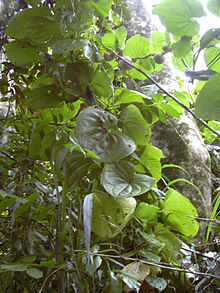- Dioscorea bulbifera
-
Dioscorea bulbifera
Air potato
Scientific classification Kingdom: Plantae (unranked): Angiosperms (unranked): Monocots Order: Dioscoreales Family: Dioscoreaceae Genus: Dioscorea Species: D. bulbifera Binomial name Dioscorea bulbifera
L.Dioscorea bulbifera, the Air potato, is a yam species. It is also known as Varahi in Sanskrit, Kaachil in Malayalam and Dukkar Kand in Marathi. The Air potato plant is native to Africa and Asia.
Contents
Description
Dioscorea bulbifera is a perennial vine with broad leaves and two types of storage organs. The plant forms bulbils in the leaf axils of the twining stems, and tubers beneath the ground. These tubers are like small, oblong potatoes, and they are edible and cultivated as a food crop, especially in West Africa. The tubers often have a bitter taste, which can be removed by boiling. They can then be prepared in the same way as other yams, potatoes, and sweet potatoes. The air potato is one of the most widely-consumed yam species.It can grow up to 150 feet tall. Air potato can grow extremely quickly, roughly 8 inches per day, and eventually reach over 60 feet long. It typically climbs to the tops of trees and has a tendency to take over native plants. New plants develop from bulbils that form on the plant, and these bulbils serve as a means of dispersal. The aerial stems of air potato die back in winter, but resprouting occurs from bulbils and underground tubers. The primary means of spread and reproduction are via bulbils. The smallest bulbils make control of air potato difficult due to their ability to sprout at a very small stage. The vine produces small white flowers, however these are rarely seen when it grows in Florida.
Uses
Air potato has been used as a folk remedy to treat conjunctivitis, diarrhea and dysentery, among other ailments.[1]
Toxicity
Uncultivated forms, such as those found growing wild in Florida can be poisonous. These varieties contain the steroid, diosgenin, which is a principal material used in the manufacture of a number of synthetic steroidal hormones, such as those used in hormonal contraception.[2] There have been claims[3] that even the wild forms are rendered edible after drying and boiling, leading to confusion over actual toxicity.
Invasive species
In some places, such as Florida where it is considered a noxious weed, it is an invasive species because of its quick-growing, large-leafed vine that spreads tenaciously and shades out any plants growing beneath it. The bulbils on the vines sprout and become new vines, twisting around each other to form a thick mat. If the plant is cut to the ground, the tubers can survive for extended periods and send up new shoots later.[4]
References
- ^ Duke, James A.; Judith L. DuCellier (1993). Handbook of Alternative Cash Crops. CRC Press. ISBN 0849336201. http://books.google.com/books?id=-tg7R4hU8hkC&printsec=frontcover#PPA230,M1.
- ^ "Meet the plants: Dioscorea bulbifera". National Tropical Botanical Garden. http://www.ntbg.org/plants/plant_details.php?plantid=4171. Retrieved 2007-11-17.
- ^ "Pest Plants, Air Potato: Dioscorea bulbifera". WalterReeves.com. Jan 2010. http://www.walterreeves.com/landscaping/article.phtml?cat=10&id=33. Retrieved 2010-01-29.
- ^ "Air potato takes over". The Nature Conservancy. http://www.nature.org/initiatives/invasivespecies/misc/airpotato.html. Retrieved 2007-11-17.
External Links
- Species Profile- Air Potato (Dioscorea bulbifera), National Invasive Species Information Center, United States National Agricultural Library. Lists general information and resources for air potato.
Further reading
- Van Wyk, Ben-Erik (2005). Food Plants of the World. Portland, Oregon: Timber Press, Inc. ISBN 0-88192-743-0
- http://plants.ifas.ufl.edu/node/133 General information about Dioscorea Bulbifera from University of Florida
Categories:- Dioscorea
- Flora of Africa
- Flora of Asia
- Invasive plant species
- Invasive plant species in Florida
- Flora of Christmas Island
Wikimedia Foundation. 2010.


